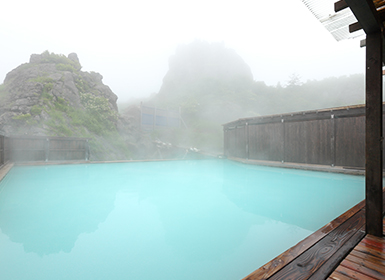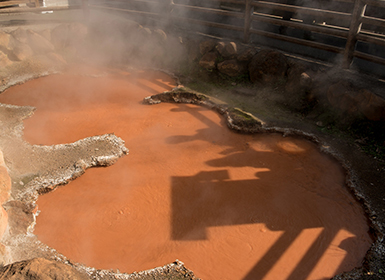Qualities of various types of spring water


About spring water quality
Onsen has various characteristics such as its chemical composition, temperature, properties of liquid (pH), color, smell, taste, and texture.
Quality of spring water in Onsen is determined by chemical compounds and its contained amount, and it can be classified into 10 types as below.
If a certain Onsen doesn’t meet requirement of pure spring water, it is no longer called as Onsen. In that case, it is described as “Onsen given in Hot Spring Act” or “Onsen given in Article 2 of Hot Spring Act ” in Hot Spring Analysis.
It used to employ so-called “old spring quality names" such as carbonated spring, baking soda spring, salt spring, real bitter spring, mirabilite springs, plaster spring, vitriol spring, etc., but the Ministry of the Environment updated it into “new spring quality names” whose names informed main chemical components of each springs in 1978.
1.Simple Springs※Click the name of spring water quality to see facilities list for members(Japanese)
- Standard
- Hot spring that contains mass of dissolved ingredients (exclusive of those that are in the form of gas) 1,000 mg/lg or below, and the temperature measured at the gushing point is 25 degree Celsius or more. Among them, those with pH 8.5 or higher are called "Simple alkaline Onsen".
- Characteristics
- It is described as sweet, mild texture, and little irritation to the skin. Simple alkaline Onsen provides us smooth feelings when bathing.
- For example,
- Gero Onsen in Gifu Prefecture、Kakeyu Onsen in Nagano Prefecture, etc.
- Indication of each spring water quality
- For bathing: Autonomic Instability, Insomnia, and Depression
2.Chloride Spring※Click the name of spring water quality to see facilities list for members(Japanese)
- Standard
- Hot spring that contains mass of dissolved ingredients (exclusive of those that are in the form of gas) 1,000 mg/kg or more, and the principal ingredients of negative ions are chloride ions.
- Characteristics
- It is classified as sodium-chloride spring, calcium-chloride spring, magnesium-chloride spring, and so on, depending on the main ingredients of the cation. This is comparatively major spring water quality in Japan. It tastes salty when tasted as the principal components are salts, and when the concentration of salinity is high or it contains large amount of magnesium, it tastes bitter.
- For example
- Atami Onsen in Shizuoka Prefecture、Katayamazu Onsen in Ishikawa Prefecture, etc.
- Indication of each spring water quality
- For bathing: Cuts, Peripheral circulation failure, Excessive sensitivity to cold, Depression, Dry skin
For drinking: Atrophic gastritis, and Constipation
3.Carbonated Springs※Click the name of spring water quality to see facilities list for members(Japanese)
- Standard
- Hot spring that contains mass of dissolved ingredients (exclusive of those that are in the form of gas) 1,000 mg/lg or more, and the principal ingredients are hydrogen carbonate ion.
- Characteristics
- It is classified into sodium hydrogen carbonate spring, calcium hydrogen carbonate spring, magnesium hydrogen carbonate spring and so on, depending on the main component of the cation. Calcium-bicarbonate springs may generate calcareous hot spring deposits and precipitates.
- For Example
- Kawayu Onsen in Wakayama Prefecture, Otari Onsen in Nagano Prefecture, etc.
- Indication of each spring water quality
- For bathing: Cuts, Peripheral circulation failure, Excessive sensitivity to cold, and Dry skin
For drinking: Gastroduodenal ulceration, Reflux esophagitis, Impartial glucose tolerance (Diabetes), and Hyperuricemia (gout)
4.Sulphate Springs※Click the name of spring water quality to see facilities list for members(Japanese)
- Standard
- Hot spring that contains mass of dissolved ingredients (exclusive of those that are in the form of gas) 1,000 mg/lg or more, and the principal ingredients of anion are sulfate ion.
- Characteristics
- It is classified into sodium-sulfate spring, calcium-sulfate spring, magnesium-sulfate spring, and so on, depending on the main component of the cation.
- For exmaple
- Houshi Onsen in Gunma Prefecture, Amagiyugashima Onsen in Shizuoka Prefecture etc.
- Indication of each spring water quality
- For bathing: Cuts、Peripheral circulation failure、Excessive sensitivity to cold、Depression、Dry skin
For drinking: Biliary dysfunction, Dyslipidemia, Constipation
5.Carbon dioxide springs※Click the name of spring water quality to see facilities list for members(Japanese)
- Standard
- Hot Spring that contains free carbonate (carbon dioxide)
1.000 mg/lg or more.
- Characteristics
- It is characterized by the fact that the small bubbles of the carbonic acid adhere to the skin to envelope the whole of the body and make people feel refreshing when bathing. However, carbon dioxide may gasify by heating. When drinking, you feel the freshness of carbonation goes down. This is comparatively rare spring water qualities. It is also so-called "Onsen bubbles".
- For exmaple
- Nagayu Onsen in Oita Prefecture is famous for its comparatively high temperature of the springwater. Kogane Onsen of Hijiori Onsenkyo in Yamagata Prefecture and so on. are famous for its comparatively low temperature.
- Indication of each spring water quality
- For bathing: Cuts, Peripheral circulation failure, Excessive sensitivity to cold, Autonomic Instability
For drinking: Gastrointestinal hypofunction
6.Ferrunbginous Springs※Click the name of spring water quality to see facilities list for members(Japanese)
- Standard
- Hot spring that contains total iron ion(Fre++ or Fe+++) 20 mg/kg or more. It is classified into bicarbonate type and sulfate types depending on the anion.
- Characteristics
- It is characterized the fact that they change color to the red when exposed to the air, as iron is oxidized.
- For exmaple
- Arima Onsen in Hyogo Prefecture
- Indication of each spring water quality
- For Drinking: Iron-deficiency anemia
7.Acidic Springs※Click the name of spring water quality to see facilities list for members(Japanese)
- Standard
- Hot Spring that contains hydrogen ion 1 mg/kg or more.
- Characteristics
- It tastes sour. It has a sterilization effect. This can be largely found in all over Japan, though hardly in Europe.
- For exmaple
- Tamagawa Onsen in Akita Prefecture, Sukawa Onsen in Iwate Prefecture, etc.
- Indication of each spring water quality
- For bathing: Atopic dermatitis、Plaque psoriasis、Impartial glucose tolerance (Diabetes)、Epidermoid suppuration
8.Lodine-containing springs※Click the name of spring water quality to see facilities list for members(Japanese)
- Standard
- Hot spring that contains mass of iodide ions 10mg/kg or more.
- Characteristics
- They are mainly found among non-volcanic Onsen and become yellow when left for while.
- For exmaple
- Kowakubi Onsen in Akita Prefecture, Maenohara Onsen in Tokyo, etc.
- Indication of each spring water quality
- For drinking: Dyslipidemia
9.Sulphur Springs※Click the name of spring water quality to see facilities list for members(Japanese)
- Standard
- Hot spring that contains total sulphur 2mg/kg or more.
- Characteristics
- It is classified into sulfur type and hydrogen sulfide type, and the spring quality can be found comparatively largely in Japan. The peculiar odor similar to the rotten odor of eggs is due to hydrogen sulfide.
- For exmaple
- Nikko Yumoto Onsen in Tochigi Prefecture, Kowakudani Onsen of Hakone Onsenkyo in Kanagawa Prefecture, etc.
- Indication of each spring water quality
- For bathing: Atopic dermatitis、Plaque psoriasis、Chronic eczema、Epidermolysis( and Peripheral circulation failure as well in hydrogen sulfide type)
For drinking: Impartial glucose tolerance (Diabetes)、Dyslipidemia
10.Radioactive Springs※Click the name of spring water quality to see facilities list for members(Japanese)
- Standard
- Hot spring that contains 3 nanocuries(8.25 mache unit or more) /1kg or more of Radon.
- Characteristics
- We tend to believe that radioactivity is harmful to the human body, but it is much smaller than that of X-rays and so on in radiation dosage. And it has been proved that very small amounts of radioactivity have a positive effect on the human body.
- For exmaple
- Misasa Onsen in Tottori Prefecture, Masutomi Onsen in Yamanashi Prefecture, etc.
- Indication of each spring water quality
- For bathing: Hyperuricemia (gout)、Rheumatoid arthritis、Ankylosing spondylitis, etc.
Look at a comparison table of new and old spring water names
| No | Spring quality names for notice | Old spring water quality name | New spring water quality name |
|---|---|---|---|
| 1 | Simple springs | Simple thermals | Simple springs Simple alkaline springs |
| 2 | Chloride springs | Salt springs Earthy chloride containing-salt springs Alkali earth metal containing-salt springs |
|
| 3 | Carbonate springs | Bicarbonate springs Baking soda springs |
Calcium(-magnesium)-hydrogen carbonate springs Sodium-hydrogen carbonate spring |
| 4 | Sulfate springs | Sulphated springs Real bitter springs Mirabilite springs Gypsum springs |
Sulfate springs Magnesium-sulfate springs Sodium-sulfate springs Calcium-sulfate springs |
| 5 | Carbon dioxide springs | Simple carbon dioxide springs | Simple carbon dioxide springs |
| 6 | Ferruginous springs | Iron springs Iron carbon dioxide springs Vitriol spring |
Iron Springs Iron(Ⅱ) - hydrogen carbonate springs Iron(Ⅱ) - sulfate springs |
| 7 | Acidic springs | Simple carbon dioxide springs | Simple carbon dioxide springs |
| 8 | Lodine-containing springs | Lodine-containing-salt springs | Lodine-containing- sodium-chloride springs |
| 9 | Sulphur springs | Sulphur springs Hydrogen sulphide springs |
Sulphur springs Sulphur springs(Hydrogen sulfide type) |
| 10 | Radioactive springs | Radioactive springs | Simple weak radioactive springs Simple radioactive springs Weak radioactivity containing - - springs |
| No,1 | |
|---|---|
| Spring quality names for notice | Simple springs |
| Old spring water quality name | Simple thermals |
| New spring water quality name | Simple springs Simple alkaline springs |
| No,2 | |
| Spring quality names for notice | Chloride springs |
| Old spring water quality name | Salt springs Earthy chloride containing-salt springs Alkali earth metal containing-salt springs |
| New spring water quality name | Sodium-chloride springs Magnesium-chloride springs Calcium-chloride springs |
| No,3 | |
| Spring quality names for notice | Carbonate springs |
| Old spring water quality name | Bicarbonate springs Baking soda springs |
| New spring water quality name | Calcium(-magnesium)-hydrogen carbonate springs Sodium-hydrogen carbonate spring |
| No,4 | |
| Spring quality names for notice | Sulfate springs |
| Old spring water quality name | Sulphated springs Real bitter springs Mirabilite spings Gypsum springs |
| New spring water quality name | Sulfate springs Magnesium-sulfate springs Sodium-sulfate springs Calcium-sulfate springs |
| No,5 | |
| Spring quality names for notice | Carbon dioxide springs |
| Old spring water quality name | Simple carbon dioxide springs |
| New spring water quality name | Simple carbon dioxide springs |
| No,6 | |
| Spring quality names for notice | Ferruginous springs |
| Old spring water quality name | Iron springs Iron carbon dioxide springs Vitriol spring |
| New spring water quality name | Iron Springs Iron(Ⅱ) - hydrogen carbonate springs Iron(Ⅱ) - sulfate springs |
| No,7 | |
| Spring quality names for notice | Acidic springs |
| Old spring water quality name | Simple carbon dioxide springs |
| New spring water quality name | Simple carbon dioxide springs |
| No,8 | |
| Spring quality names for notice | Lodine-containing springs |
| Old spring water quality name | Lodine-containing-salt springs |
| New spring water quality name | Lodine-containing- sodium-chloride springs |
| No,9 | |
| Spring quality names for notice | Sulphur springs |
| Old spring water quality name | Lodine-containing-salt springsSulphur springs Hydrogen sulphide springs |
| New spring water quality name | Sulphur springs Sulphur springs(Hydrogen sulfide type) |
| No,10 | |
| Spring quality names for notice | Radioactive springs |
| Old spring water quality name | Radioactive springs |
| New spring water quality name | Simple weak radioactive springs Simple radioactive springs Weak radioactivity containing - - springs Radioactivity containing - - spirings |



